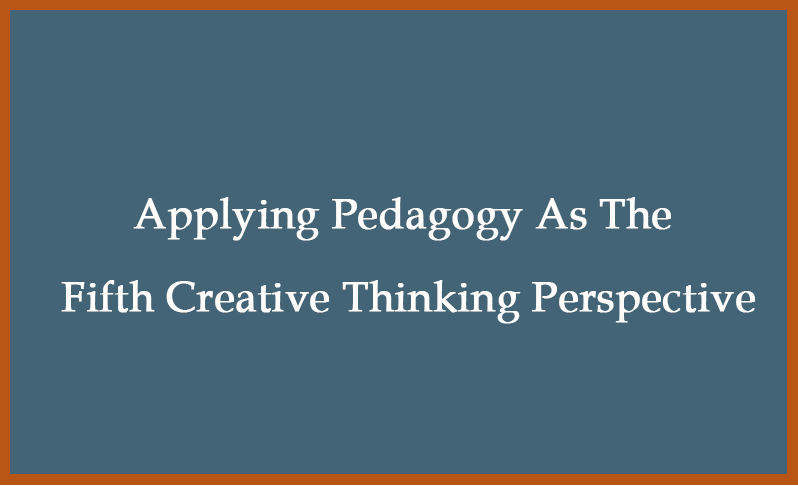Hasn’t the time come for creative thinking researchers to begin a scholarly conversation about the fifth P? What, you didn’t realize there were already four Ps?
In our Introduction To Applied Creative Thinking (2012), we explain that since Rhodes (1965) “creative thinking theorists tend to regard the field from four different perspectives, commonly called the Four Ps”:
- The Creative Process “consists of those learned skills that innovative thinkers employ.”
- The Creative Person “is the focus of studies that examine those personality traits that produce a creative thinker.”
- The Creative Press “is a term used to describe the environment that contributes to optimal creativity.”
- The Creative Product is “the end result of the previous Ps—did the process, press, and person produce something tangible that is useful?” (pp. 2-4).
For us the fifth P is pedagogy, which Holberg and Taylor (2005) define as “incarnational teaching, that is, the embodiment of principles in practice.” Perhaps we believe in the importance of pedagogy because we have spent our careers in higher education, most recently focusing on professional development, or maybe it’s simply that we subscribe to the old adage that you don’t completely know something until you can teach it to someone else. No matter the source of our belief, we have noticed the past few years as we review the literature on applied creative thinking that too few researchers try to answer the question, “How can I utilize all these insights into creativity in my teaching?”
Related Reading: Sign up for our free newsletter to receive new articles!
Transforming Students Into Creative Thinkers
Stated in other terms, we are vitally concerned with how to transform our students into creative thinkers. So far, our response has been twofold. First, we developed an 18-hour Minor in Applied Creative Thinking wherein students begin the minor with CRE 101 Introduction to Applied Creative Thinking and complete the minor with a capstone course. The other 12 hours can be fulfilled by students taking various creativity courses in specific disciplines (e.g., psych, education, business) or within the minor (e.g., an innovation course, a course into creativity research, and even a course in teaching the subject). And to provide continuity between the courses, as well as a common vocabulary, we have written the aforementioned Introduction To Applied Creative Thinking (2012) as well as Teaching Applied Creative Thinking (2013).
Combining Pedagogy and Creative Thinking
So what do we think should be done to bring the fifth P, pedagogy, into the spotlight?
- As we alluded to earlier, researchers need to explore how creative strategies are best taught. For instance, we checked the Creativity Research Journal website that lists their “ten most read articles,” and not one of them is focused on pedagogy. Interestingly, we wrote Teaching Applied Creative Thinking because we could not find a suitable textbook in that area.
- Graduate schools need a greater emphasis on pedagogy—not just the pedagogy of creativity, but pedagogy in general, but that’s another column . . . if not book.
- Faculty members need to think about how to include creative thinking in their classes. Nobody we know had executed a search of America’s colleges and universities aimed at discovering how many classes have goals/student learning outcomes centered on creative thinking. And even if more higher ed faculty included such learning goals, would the students receive enough K-12 training in creative thinking to be ready for this approach
- Perhaps most important, the academy needs to admit that such a thing as the scholarship of creativity exists. After all, if you check Boyer’s seminal Scholarship Reconsidered (1990), you’ll find four categories of scholarship listed—discovery, integration, application, and teaching (what we now call the scholarship of teaching and learning)–and not one of them is the scholarship of creativity. We applaud Boyer’s emphasis on teaching, but 25 years ago, despite his rationale that the traditional definition of scholarship needed to be broadened to include social and environmental changes, the scholarship of creativity did not even receive a footnote. We often feel lucky that we work at a university that for almost half a century has recognized what it calls the “scholarship of creative endeavor.” Nonetheless, most people in higher ed don’t recognize that such a scholarship exists, and the few who do would be hard pressed to define it, come up with a rationale, or provide a research process that falls into this category.
Ultimately the pedagogy of creativity will not exist until the scholarship of creativity is developed, so get researching!
Author
 Charlie Sweet is currently Co-Director of the Teaching & Learning Center (2007+) at Eastern Kentucky University. Before going over to the dark side of administration, for 37 years he taught American Lit and Creative Writing in EKU’s Department of English & Theatre, where he also served as chair (2003-2006). Collabo-writing with Hal Blythe, he has published well over 1000 items, including 15 books; of his 11 books with New Forums. Meet Charlie.
Charlie Sweet is currently Co-Director of the Teaching & Learning Center (2007+) at Eastern Kentucky University. Before going over to the dark side of administration, for 37 years he taught American Lit and Creative Writing in EKU’s Department of English & Theatre, where he also served as chair (2003-2006). Collabo-writing with Hal Blythe, he has published well over 1000 items, including 15 books; of his 11 books with New Forums. Meet Charlie.



